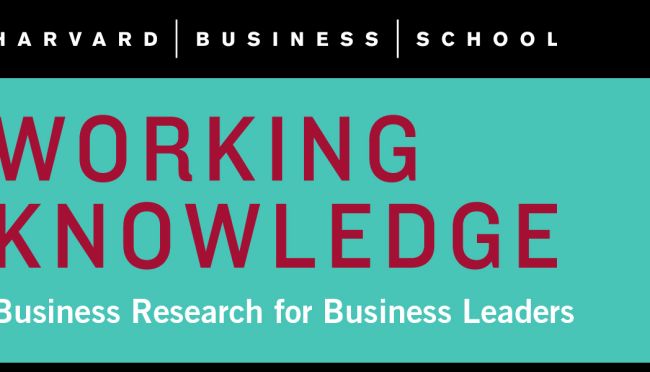Measurement and Metrics →
→

- 06 Dec 2021
- Research & Ideas
The Popular Stock Metric That Can Lead Investors Astray
Investors may rely too heavily on a financial measure that no longer reflects the economic fundamentals of modern business. What should investors do? Research by Charles C.Y. Wang and colleagues. Open for comment; 0 Comments.

- 08 May 2020
- Working Paper Summaries
Corporate Environmental Impact: Measurement, Data and Information
This paper proposes a methodology for investors, companies, or regulators to use established environmental resources, reasonably accessible in the public domain, to measure an organization’s environmental impact from operations. These measurements contain information that is different from environmental ratings widely used by investors and other stakeholders.

- 18 Feb 2020
- Working Paper Summaries
A Preliminary Framework for Product Impact-Weighted Accounts
Although there is growing interest in environmental, social, and governance measurement, the impact of company operations is emphasized over product use. A framework like this one that captures a product’s reach, accessibility, quality, optionality, environmental use emissions, and end of life recyclability allows for a systematic methodology that can be applied to companies across many industries.

- 11 Feb 2019
- Working Paper Summaries
The IBM PC
The IBM PC was the first computer platform to be open by choice and not because of financial constraints. Initially, this openness kept IBM competitive. But IBM’s control over two strategic bottlenecks— standards embedded in the Basic Input Output System, and system integration and manufacturing of the computer itself—turned out to be weak.

- 07 Jan 2019
- Research & Ideas
The Better Way to Forecast the Future
We can forecast hurricane paths with great certainty, yet many businesses can't predict a supply chain snafu just around the corner. Yael Grushka-Cockayne says crowdsourcing can help. Open for comment; 0 Comments.

- 28 Nov 2018
- HBS Case
On Target: Rethinking the Retail Website
Target is one big-brand retailer that seems to have survived and even thrived in the apocalyptic retail landscape. What's its secret? Srikant Datar discusses the company's relentless focus on online data. Open for comment; 0 Comments.

- 12 Mar 2018
- Working Paper Summaries
Using Online Prices for Measuring Real Consumption Across Countries
The increasing availability of big data can improve measurement of real consumption in closer to real time. This study shows that online prices may enhance data of the International Comparisons Program, dramatically improving the frequency and transparency of purchasing power parities compared with traditional data collection methods.

- 05 Mar 2018
- Working Paper Summaries
Nowcasting Gentrification: Using Yelp Data to Quantify Neighborhood Change
This study finds that data from digital platforms (in this case, Yelp) can help forecast which neighborhoods are gentrifying and provide new ways to measure business landscape changes that accompany demographic changes.

- 09 Mar 2017
- Working Paper Summaries
Exploring the Relationship Between Architecture Coupling and Software Vulnerabilities: A Google Chrome Case
Managing software vulnerabilities is a top issue in today’s society. By studying the Google Chrome codebase, the authors explore software metrics including architecture coupling measures in relation to software vulnerabilities. This paper adds new findings to research on software metrics and vulnerabilities, bringing the field closer to generalizable and conclusive results.

- 18 Jan 2017
- Working Paper Summaries
The Ties that Bind: Railroad Gauge Standards, Collusion, and Internal Trade in the 19th Century US
The author studies the conversion of 13,000 miles of railroad track to standard gauge in the southern United States in 1886 as a large-scale natural experiment in technology standards adoption that instantly integrated the South into the national transportation network.

- 28 Feb 2013
- Working Paper Summaries
Do Display Ads Influence Search? Attribution and Dynamics in Online Advertising
The introduction of online metrics such as click through rate (CTR) and cost per acquisition (CPA) by Google and other online advertisers has made it easy for marketing managers to justify their online ad spending in comparison to the budgets used for television and other media. However, these metrics suffer from two fundamental problems: (a) they do not account for attribution, since they give credit to the last click and ignore the impact of other ad formats that may have helped a consumer move down the conversion funnel, and (b) they ignore the dynamics, since they only account for the immediate impact of ads. As firms spend more of their ad dollars on online search and display, managers and researchers alike recognize a need for more careful attribution adjustment that takes into account the journey consumers follow before conversion as well as account for the impact of ads over time. In this paper, the authors use time series models to infer the interaction between search and display ads and also capture their impact over time. Examining data from a bank that used online advertising to acquire new customers for its checking account, the authors found that display ads have a significant impact on search applications, as well as clicks. The majority of this spillover was not instant, but took effect only after two weeks. On the other hand, search advertising did not lead to an increase in display applications. However, search ads showed significant dynamic effects on search applications that made them very cost effective in the long run. Key concepts include: Classic metrics used in practice are highly biased since they do not account for the effects documented in this study. As a result, firms may be making suboptimal budget allocation decisions. Managers should carefully consider the interaction and dynamic effects of search and display advertising. In the study, revised measures of ad effectiveness lead to a very different budget allocation than the one used currently by the firm. Even though the proposed allocation gives credit to display due to its effect on search applications, the search ad budget should be increased by 36% from its current level due to its strong dynamic effects. The display ad budget should be decreased by 31%. Closed for comment; 0 Comments.
- 13 Feb 2013
- Research & Ideas
5 Weight Loss Tips From Behavioral Economists
Behavioral economists study what motivates people to buy, save, donate, and any other number of actions that build society. The following studies reveal proven methods of encouraging healthy eating and exercise. Open for comment; 0 Comments.
- 04 Feb 2013
- Research & Ideas
Are the Big Four Audit Firms Too Big to Fail?
Although the number of audit firms has decreased over the past few decades, concerns that the "Big Four" survivors have become too big to fail may be a stretch. Research by professor Karthik Ramanna and colleagues suggests instead that audit firms are more concerned about taking risks. Closed for comment; 0 Comments.
- 14 Jun 2010
- Research & Ideas
The Hard Work of Measuring Social Impact
Donors are placing nonprofits on the hot seat to measure social performance. Problem is, there is little agreement on what those metrics should be. Professor Alnoor Ebrahim on how nonprofit managers should respond. Closed for comment; 0 Comments.
- 04 Oct 2004
- Research & Ideas
Start to Measure Your E-commerce Success
After the dot-com fallout, surviving companies needed to sharpen strategy and analyze metrics much better. Visiting professor Marc J. Epstein shows how to put metrics to work. Closed for comment; 0 Comments.

This Workplace Certification Made Already Safe Companies Even Safer
New research by Michael Toffel and colleagues confirms what workplace safety advocates have long claimed: Adopting OHSAS 18001 reduces worker injuries and improves a brand's image. Open for comment; 0 Comments.